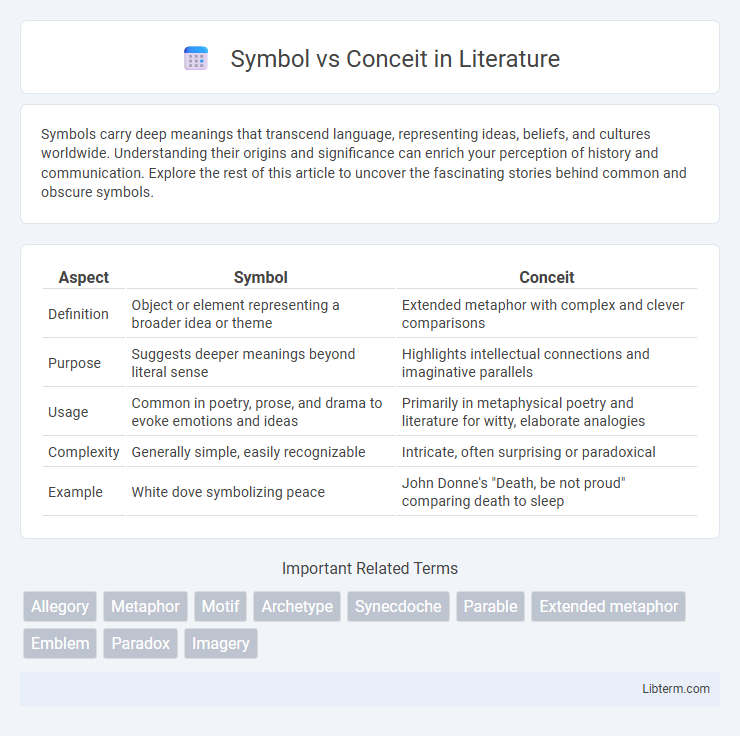Symbols carry deep meanings that transcend language, representing ideas, beliefs, and cultures worldwide. Understanding their origins and significance can enrich your perception of history and communication. Explore the rest of this article to uncover the fascinating stories behind common and obscure symbols.
Table of Comparison
| Aspect | Symbol | Conceit |
|---|---|---|
| Definition | Object or element representing a broader idea or theme | Extended metaphor with complex and clever comparisons |
| Purpose | Suggests deeper meanings beyond literal sense | Highlights intellectual connections and imaginative parallels |
| Usage | Common in poetry, prose, and drama to evoke emotions and ideas | Primarily in metaphysical poetry and literature for witty, elaborate analogies |
| Complexity | Generally simple, easily recognizable | Intricate, often surprising or paradoxical |
| Example | White dove symbolizing peace | John Donne's "Death, be not proud" comparing death to sleep |
Introduction: Understanding Symbols and Conceits
Symbols represent ideas or qualities beyond their literal meaning, often rooted in universal or cultural significance, such as a dove symbolizing peace. Conceits are extended metaphors that create complex and often surprising comparisons between seemingly unrelated objects or ideas, like John Donne's comparison of two lovers to the legs of a compass. Understanding the distinction enhances literary analysis by highlighting how symbols convey straightforward meanings while conceits invite deeper, intricate interpretation.
Defining Symbol: Meaning and Usage
A symbol is a figure, object, or image used to represent abstract ideas or concepts beyond its literal sense, functioning as a meaningful sign within a cultural or literary context. Commonly employed in literature, art, and communication, symbols evoke deeper understanding by connecting tangible elements with intangible meanings, such as a dove symbolizing peace or a red rose representing love. Effective use of symbols enhances thematic depth and emotional resonance, enabling readers or viewers to infer layered significance through recognizable or culturally embedded references.
Defining Conceit: Characteristics and Features
Conceit is an extended metaphor that draws a striking parallel between two seemingly unrelated concepts, often with elaborate and inventive comparisons. It is characterized by intellectual ingenuity, complex imagery, and a surprising connection that deepens the meaning of the text. Unlike a simple symbol, a conceit develops over several lines or an entire work, engaging readers in a more intricate and thoughtful reflection.
Historical Origins of Symbol and Conceit
Symbols have origins tracing back to ancient civilizations where they served as visual representations of complex ideas or concepts, often rooted in mythology, religion, and early written communication systems such as hieroglyphics. Conceits emerged during the Renaissance and Baroque periods, characterized by elaborate, extended metaphors that linked seemingly unrelated ideas to provoke intellectual insight and artistic innovation. While symbols rely on universal or culturally specific imagery, conceits emphasize inventive and often surprising comparisons derived from literary creativity.
Symbol vs Conceit: Key Differences
Symbols represent broader, often universal meanings through objects or images, while conceits are extended metaphors that create complex, imaginative comparisons between two seemingly unrelated things. Symbols rely on shared cultural understanding to convey deeper significance, whereas conceits develop intricate, witty connections that drive a poem's thematic depth. Distinctively, symbols evoke consistent interpretations across contexts, while conceits challenge readers to explore novel relationships within literary works.
Functions of Symbols in Literature
Symbols in literature function as tangible objects or elements that represent broader abstract ideas, enriching thematic depth and inviting interpretation. They create layers of meaning by connecting the concrete with the intangible, often evoking emotions or cultural associations that enhance narrative complexity. Unlike conceits, which rely on elaborate and extended metaphors, symbols operate through universally or contextually recognized significance to deepen readers' engagement with the text's underlying messages.
Functions of Conceits in Poetry
Conceits function as extended metaphors in poetry, creating complex and intellectually engaging comparisons that deepen the thematic layers and emotional impact of a poem. Unlike simple symbols that represent singular ideas, conceits elaborate on unusual or striking parallels, often bridging disparate concepts to provoke thought and insight. They enhance poetic expression by encouraging readers to explore multiple dimensions of meaning and interpretative possibilities within the poem.
Symbol and Conceit: Notable Examples
Symbols like the dove representing peace and the red rose symbolizing love appear frequently in literature and art, conveying complex ideas through simple images. Conceits, such as John Donne's comparison of two lovers to a compass in his poem "A Valediction: Forbidding Mourning," use elaborate, extended metaphors to create striking, intellectual connections. Notable examples of symbols are the green light in "The Great Gatsby" and the serpent in "Paradise Lost," while conceits prominently feature in metaphysical poetry, highlighting intricate and often surprising analogies.
Impact on Reader Interpretation
Symbols often evoke a broad range of interpretations grounded in shared cultural or universal meanings, enabling readers to connect more intuitively with the text. Conceits, characterized by their elaborate and often surprising comparisons, challenge readers to engage deeply and rethink familiar ideas, prompting a more analytical or reflective response. The impact on reader interpretation hinges on symbols' ability to resonate emotionally and conceits' power to stimulate intellectual insight.
Conclusion: Symbol or Conceit in Modern Writing
Symbols in modern writing often provide universal, layered meanings that resonate broadly, while conceits offer intricate, intellectual comparisons tailored for deeper analysis. The choice between symbol and conceit depends on the writer's intent: symbols evoke intuitive, emotional responses, whereas conceits challenge readers with elaborate, often surprising analogies. Effective modern literature frequently blends both, using symbols for thematic depth and conceits to engage critical thinking and innovation.
Symbol Infographic

 libterm.com
libterm.com